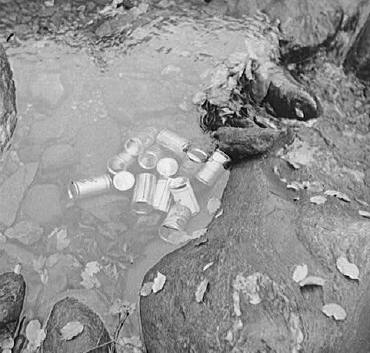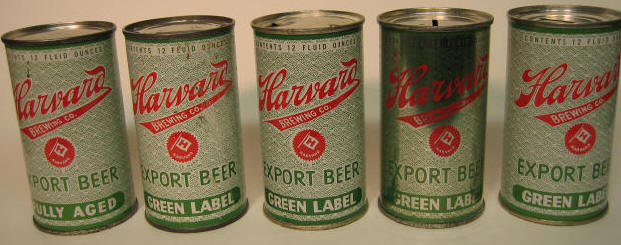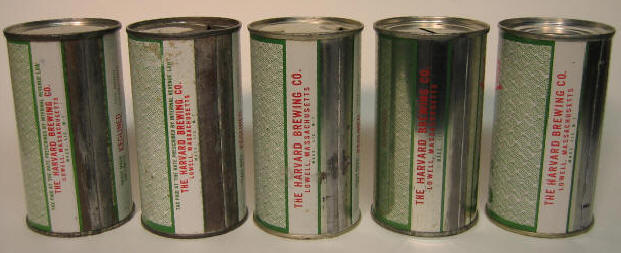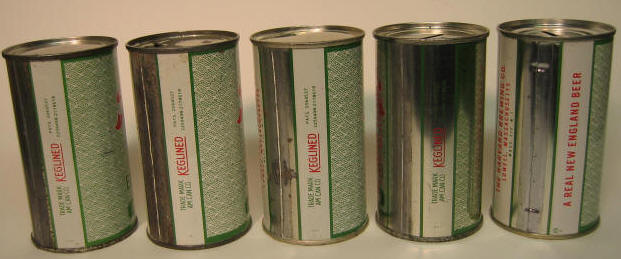Harvard Export Beer: circa 1952
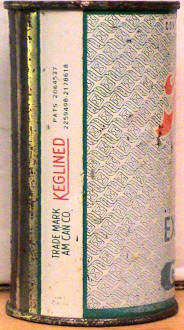 |
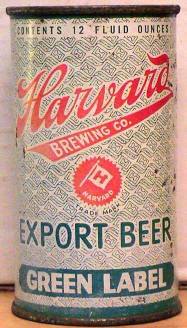 |
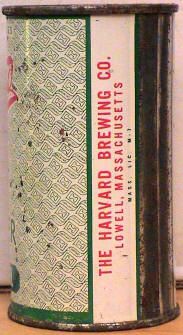 |
This can dates from the early 1950s. There are several variations. This is one of the more common. Another variation, which is much, much tougher to find, has a side panel that instead of "Keglined" reads "A Real New England Beer." There are several other Harvard cans as well, including four OIs (two Ale and two Beer). I picked this can in part because I like New England cans, but also because some friends and I dumped some of these with a metal detector along an old stone fence near a lake in western Massachusetts in June, 2003. Some of them cleaned up reasonably well, although none of them were as nice as this can.
Harvard Brewing
Harvard Brewing was in business from 1893-1920 and again after Prohibition from 1933 to 1956. It was founded as Consumer's Brewing Company in Lowell, Massachusetts. The first barrels of their beer were made in April of 1894 and were aged and ready for the market in June. The official start of business was marked by a formal opening with the company's employees and stockholders enjoying entertainment provided by an orchestra, lots of German and American food and, of course, free beer.
During the brewery's early years, a majority of the workers were German immigrants. Keeping their European traditions, in 1896 they formed the United Brewery Workmen of the U.S.A. The union was one of the first in the nation to win an eight hour workday and helped maintain excellent working conditions and benefits for its members. The union workers also built a community meeting place, Der Deutsche Halle (the German Hall) across from the brewery. It was used for union gatherings, local cultural events, and company functions.
In January 1898, a group of New York businessmen who purchased a controlling interest in the company and changed the name to Harvard Brewing, so as to distinguish the brewery from other existing Consumer's Breweries. The new ownersalso expanded the production facilities and increased the number of brands sold by the brewery to include $1000 Pure Beer Crimson Label, Dark Special, Brown Autumn Ale, Old Stock Porter, Sparkling Pale Ale and Present Use Porter. The businessmen soon immersed themselves in local politics in Lowell, to the point where in 1908, a reform mayor was elected to break the brewery's hold on local government. Members of the alcohol licensing commission, along with several of the brewery's managers, were arrested and charged with conspiracy. The death of a key witness resulted in their acquittal. The coming of Prohibition in 1920, however, fully ended Harvard Brewing political influence.
Prohibition
The brewery tried to survive Prohibition by selling soft drinks such as ginger ale, as well as “near-beer” (beer with less than half of 1 percent alcohol). Sales lagged, however so Harvard Brewery decided to make their near-beer a bit stronger than federal law permitted. Not surprisingly, their profits jumped. Their efforts, backfired in August 1925 when a truck filled with 100 barrels of Harvard Beer was hijacked in Lowell. As the hijackers were transferring the kegs of brew to their own private cars, the neighbors decided to help themselves as well. An article in the Lowell Courier-Citizen noted, "As soon as it became known in the locality what was going on, hundreds appeared and surrounded the truck. They all clamored for a chance to secure a barrel of the beer. Men came to blows and bedlam reigned. Besides the men involved, it is known that several women even procured barrels and rolled them along the sidewalks or in the streets to homes thereabouts." The police investigated and scattered the crowd including the hijackers. Inspecting the back of the truck, police discovered only 24 kegs remained of the original 100.
When Federal agents from Boston then raided the brewery, the managers refused to let them in until they had a warrant. The police could clearly hear barrels being smashed inside the building so they forced their way in and found themselves wading in four to five inches of spilled beer. Meanwhile, full kegs of Harvard beer were being tossed by more workers into the nearby River Meadow Brook. The raid was the largest in New England's prohibition history. The Federal agents confiscated over 100,000 gallons of full strength beer. A lengthy trial led to the charges being dropped against most of the company officials, although two of the owners and a manager were given fines ranging from $150 to $500. Unable after the raid to keep up mortgage payments, the brewery was auctioned off.
Post-Prohibition
As Prohibition neared its end in late 1932, a group of New York businessmen (a different group this time) began searching for a brewery to buy and restart as an investment. They picked the old Harvard Brewery in Lowell and purchased it in December 1932. When word spread that the brewery was to resume operations, over 500 men showed up looking for work. From March through September of 1933 the Harvard plant underwent a complete modernization. Besides providing jobs to brewery workers, the return of Harvard created a small economic boom for local businesses who received the building contracts and for the city which collected substantial taxes and licensing fees. The company's large investment provided Harvard with the most advanced brewing machinery available including a complete bottling production line which mechanically washed the bottles, filled them with brew, capped them off, pasteurized the product and labeled the containers automatically.
When, in September of 1933, Harvard officially opened the bottling house, the brewery's capacity reached 1,000 barrels of beer a day. The return of the previous brew master ensured that the product was of the same consistency and flavor as before prohibition and contributed to the success of sales. Harvard's only brand at first was the Green Label Lager, which is the brand of my can. It was heavily advertised and sold throughout New England. The summer and fall of 1933 saw a backlog of orders for the Green Label beer building up, keeping the brewery at maximum production. Taking advantage of the demand, the brewery expanded to other labels, Harvard Full Stock Ale, Export Beer and Porter. To keep local customers happy, Harvard maintained a policy of filling orders for Lowell clubs and distributors first.
Harvard Brewing had no connection with the University, which wasn't thrilled to have a brewery sharing its name. But in the 1950s one of the biggest billboards in Cambridge's Harvard Square advertised Harvard Brewing and featured a large quart bottle of Harvard Export Beer. Of course, the local bars made certain they had Harvard Brewing's products on tap for Harvard University's students!
Although initial sales were excellent, by 1937 the Harvard Brewing Company was headed toward bankruptcy. The result was another change in ownership, with Fritz Von Opel as the primary investor, purchasing 97 % of the shares, with his father buying the remaining 3 %. With the new investor, and some of the original 1933 management still in place, the company returned to its former position as a profitable and successful brewery.
In 1939 Harvard tried a unique marketing tool, especially for the time, a sampler package. Brewery president Walter Guyette believed that many potential customers simply did not know the difference between different types of Harvard's products. So the brewery began selling a box that held two bottles of each of Harvard's products, Harvard Export Beer, Harvard Ale, Clipper Ale and Harvard Porter. The package also contained 4 cans, two each of Harvard Export and of Harvard Ale. That made for an even dozen containers, which sold for 99 cents (advertised as a $1.30 value). The package apparently was a success, at least according to Harvard distributors.
In February of 1942, Von Opel was arrested in Palm Beach, Florida and imprisoned as a "potentially dangerous alien" despite being a citizen of the neutral European nation of Liechtenstein. However, one of the brewery's German employees was arrested for transmitting radio messages from his home to the German government about local shipping. Even worse, by 1941 German interests held a majority of the stock. Fearing that the profits would go to Nazi Germany, the US government seized the brewery under the Alien Property Custodian Act. When Von Opel was released, he fought a long, futile legal battle to regain his company from the government.
In 1951, Von Opel won a review before the United States Supreme Court. In a unanimous decision, the justices refused to return Van Opel's shares to him. The brewery continued operation under government ownership, sometimes marketing their beer under the name "Merrimack Brewing."
Some cans of Harvard Ales (OIs!) cooling in a stream for a picnic.
Collier, John. "Cooling beer in stream at state owned picnic and camping site along the Mohawk Trail, Massachusetts." 1941, October. Farm Security Administration - Office of War Information Photograph Collection (Library of Congress). [fsa 8c33448] [LC-USF34- 081427-E]The End
The government held the brewery for several more years through the 1950's. By 1956, sales of Harvard beer had declined considerably and political pressure led the government to finally release the brewery. After competitive bids were taken, Harvard Brewing Company was sold for $800,000 to a Miami, Florida real estate company. In December of 1956, the new owners turned around and resold the Harvard Brewery, this time to Peter Doelger, Inc. of New York for two million dollars. Doelger Brewing realized the poor financial situation of Harvard, and so shut down the Lowell brewery and moved production of Harvard beer to their own Hampden Brewing Company in Williamsett, Massachusetts. Doelger then stripped the brewery of all its stores, machinery and equipment and sold it off to companies as far away as South America. Although Doelger had promised to keep all former Harvard workers employed, only a few people were kept on the payroll and offered permanent positions in Williamsett. The brewery's buildings did not long survive the sale. The lager house was heavily damaged in a fire in 1957 and was torn down in 1961. Most of the other structures were razed in the early 1960s to make room for a Sears shopping center.
Harvard Can Variations
There are five variations of this can. This article was written by Ron Shattuck for the Pickwick Chapter newsletter. Used with permission.
All descriptions go from left to right.
The first can has fully aged on the bottom of the face . It is from American Can Co., and is IRTP. This is the first of the green label cans. It's not the easiest to find but it's out there.
The second can the words green label has replaced fully aged at the bottom of the face. This can is also IRTP. This is only the 2nd indoor example of this can that I know of. Dave Lang has dumped two of these. This is a real tough can to find in any condition. (check your shelves and trade stock you might have one )
The third can is the most common of all the green labels. it is the same as the previous can except it dose not have the IRTP statement.
The fourth can is a test can that came from Keith Norton's famous "bank heist" it was included in about a case of different test cans that were saved by a worker at the American can co. The only difference from the previous can is it has metallic green and silver, instead of enamel white and green.
The fifth can is the only one in the line up made by Continental Can Co. At first glance it looks like the common green label, but if you look closer at the face of the label there is a fine line boarder around the words Harvard Export Beer. (I don't think you can see it too well in my pictures) also on the back on the right of the seam. Instead of a panel that reads Keglined. This one is boldly printed a real New England beer.
Brands of beer produced in cans by Harvard Brewing.
Harvard Ale
Harvard Export Beer
Connecticut Yankee Ale (under both "'Harvard Brewing" and "Merrimack Brewing")
Connecticut Yankee Beer (under both "'Harvard Brewing" and "Merrimack Brewing")
Golden Brau
Old Bohemian Light Beer
Old Bohemian Bock Beer
Sources Used:
Cushman, Gary, Lang, Dave, et al. New England Breweriana (Altglen, PA: Schiffer Books, 2001) 100-105.
Lang, David. "Fair Harvard" Rustlings (have to look up date, sorry) 5-8.
Van Wieren, Dale P. American Breweries II (West Point, PA.: East Coast Breweriana Association, 1995) 143.
Websites:
Library of Congress, American Memory Collection
(additions and corrections always welcome. email me.)

